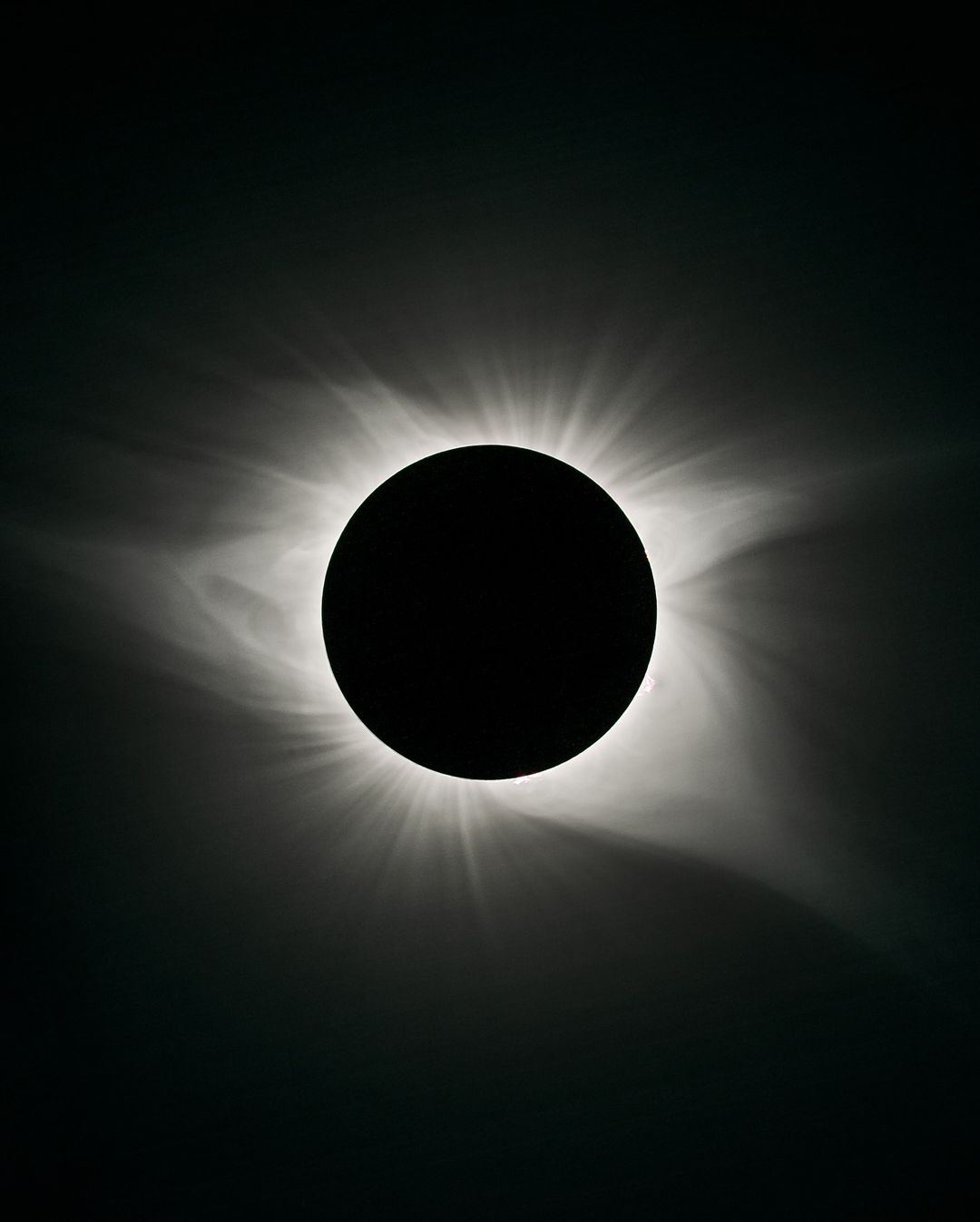Abdullah's Notes

The Experience of a Total Solar Eclipse
26 Jun 2025Photograph of the April 8th 2024 Eclipse by @neohumanity
I arrive in Montreal just in time for the eclipse. As I get off the metro to walk toward the Montreal Science Centre, the eclipse has already begun. Hundreds, perhaps thousands of people are all walking to the science centre at the same time. One would think the crowds are headed for a concert venue.
During a partial eclipse, if you pay attention to the light around you, it feels... wrong. Something feels off about it. The sun no longer being a neat disc of light, but a chipped off circle, makes for interesting interplays of light and dark on the edges of every object, make all shadows seem "off", without us being able to pinpoint exactly why.
The crowd's energy is palpable. People keep trying to get a glimpse of the sun. Even when stopped at intersections, they are looking up at the sun through their glasses while they wait.
A short 10 minute walk later, I arrive at the science centre's plaza, where thousands of others have gathered for the exact same reason. People have brought picnic chairs and snacks to comfortably enjoy the event. One can't help but adore humanity - for these few hours, the veneer of errands, made-up responsibilities and stressors in life have taken a back-seat as everyone gathers to watch a giant rock float across the sun.
20 minutes to go, and the Sun is starting to become a crescent, waning every minute. The excitement in the crowd is slowly building up.
With 10 minutes to go, it starts to get a little bit darker. The sun is getting thinner and thinner.
With 5 minutes to go, everything has become noticeably dark. The wind has picked up slightly, and there is an eerie chill in the air.
1 minute to go. The sky resembles that of dusk. The colors seem to have drained from everything. The sun looks like nothing but a thin sliver through the glasses, shrinking before your eyes.
All eyes are on the sun, waiting for that sliver to completely vanish. A couple of seconds later... it is gone completely.
Totality.
Everyone takes their glasses off to witness with their naked eyes a dazzling spectacle. The sky is the color of dusk - the deep, almost-night blue you see about an hour after sunset on a clear day. The air far away from you in every direction, outside the shadow of the moon, is still lit up by sunlight, giving the horizon a golden glow in every direction. It looks like sunset wherever you face.
Meanwhile, right above you, things are even more unusual. Scattered across the dusky sky, are Venus, Jupiter and some bright stars. And right there in the middle of the sky, is the eclipsed sun - a pitch black circular void that looks like a hole in the sky, surrounded by dazzling and crisp white wisps of light - the Sun's outer atmosphere (corona). No picture or video can do justice to how incredible this looks. No screen or paper is both bright enough to capture how sharp and bright the corona looks, especially against the dark sky, and simultaneously dark enough to depict just how dark the moon's silhouette - a deep black hole in the middle of the sky - looks like.
And that's just the visuals.
During an eclipse, the temperature drops a couple degrees. There is a palpable chill in the air. The temperature difference from the surrounding air causes an eclipse-breeze. The change in light and temperature makes the animals think it is time to call it a day - you begin to hear crickets and birds all around you. The blockage of the sunlight, and our eyes adjusting to the dark makes everything look like someone lowered the saturation of all the colors in the world.
It is an experience for all your senses. No wonder every culture has such extreme myths surrounding total eclipses.
In two places along the edge of the moon, we saw tiny orange-red dots: solar prominences. Prominences are loops of plasma bursting from the surface of the sun that form within a day and last for a couple of months. To be able to see that with your eyes during an eclipse is rare and incredible.
Before long, and almost certainly too soon, the moon slowly glides over and begins revealing the sun again. The very first flash of sunlight comes through a valley or crater on the surface of the moon, crating a sharp burst of light on the edge in one spot. The eclipse looks like a diamond ring. This is your cue to get ready to put the glasses back on. The diamond on the ring continues to grow brighter and brighter, and, just before a bright sliver of the sun comes into view, you put your glasses back on. The sliver of the sun re-appears, slowly growing into a crescent.
All around you, it starts to get brighter again. The colors return to everything. The sky becomes a brighter blue. The breeze subsides. The chill in the air is gone. There is no longer a gaping hole in the sky. The surreal experience is over in a little over a minute. The crowd dissipates and life goes back to normal.
Except for you. Your life will never be normal again. This experience will live with you. Not just the aesthetics of it, but the gravity and the profundity of having witnessed something so much bigger than you, that, somehow, still made you feel like a part of this enormous universe.